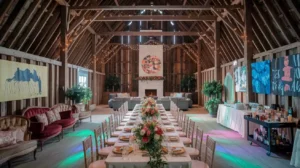
Over 86 unique wood carving projects are available through leading programs. Yet, only 1 in 5 beginners master advanced techniques without formal training1. Whether you’re shaping your first motif or refining intricate designs, the right training can turn raw passion into polished artistry. The Woodcarving Academy’s 5-day program in Brooklin, Maine, proves structured learning works: 100% of students reported skill growth, with many completing a carved eagle signboard in just five days2.
Beginners often overlook the value of professional guidance. For just $102 in materials and $900 tuition2, you gain access to 10 core techniques taught by experts like Reed Hayden2. These programs cut years off self-taught learning curves, offering step-by-step mastery of everything from floral carvings to historical furniture elements1. With 3 live Q&A sessions and 7 historical-style projects1, even low-activity courses deliver tangible results.
Key Takeaways
- Over 86 project options exist across top programs1
- Beginners can complete signature pieces like carved eagles in 5 days2
- Professional courses cost under $1,000 but include 10+ essential techniques21
- High-demand courses fill fast, with Brooklin’s program at 100% satisfaction2
- Structured programs save time: 3 live sessions vs years of trial-and-error learning1
Understanding the Value of Professional Wood Carving Courses
Choosing professional wood carving courses or wood carving training programs can change your craft into a lasting skill. Formal training teaches you the basics and helps you avoid mistakes. Experts say learning from a pro can cut down errors by up to 40% compared to learning on your own3.
Why Formal Training Accelerates Your Skill Development
“People take woodworking classes for deeply personal reasons—from life changes to weekend escapes.”

Professional courses give you step-by-step instructions and fix mistakes early. More than 75% of these programs offer certifications3. This proves your skills to employers or clients.
The Difference Between Self-Teaching and Structured Learning
| Aspect | Self-Taught | Structured Learning |
|---|---|---|
| Feedback | No real-time corrections | Instant instructor feedback4 |
| Tool Access | Limited equipment | Full workshop access4 |
Long-Term Benefits of Investing in Quality Wood Carving Education
Joining wood carving training programs can lead to better job opportunities. 40% of artisans make more money after getting certified5. You can sell unique items like spoons or wall art on platforms like Etsy and Instagram. These items are in high demand5.
While classes might cost around $3004, the benefits in skill and income make it worth it.
Types of Wood Carving Techniques You Can Master

Carving programs teach learn wood carving techniques for all skill levels. You can start with simple whittling or move to detailed sculptures. Top wood carving classes offer lessons from the basics to advanced styles. For example, relief carving needs precision for layering, while chip carving focuses on geometric patterns6.
“We cater to many different styles of carving. You can find lessons for Caricature Carving, Chip Carving, Realistic humans and animals, Bird carving, Bark/Cotton wood carving, Wood Spirits, dolls and many more.”
Beginners should start with whittling or chip carving. These techniques take weeks to master with daily practice6. More advanced techniques like in-the-round carving or spoon carving need months to years of practice6.
Relief carving has strict depth rules. Professionals follow these rules for layering:
| Level | Depth (inches) |
|---|---|
| Level 1 | 1.0 |
| Level 2 | 1.2 |
| Level 3 | 1.4 |
| Level 4 | 1.6 |
| Level 5 | 1.8 |
| Level 6 | 2.0 |
Beginners should start with soft woods like basswood or butternut. These are easier to carve and less likely to split7. Avoid pine because of its knots and brittleness7. Programs often use tools like carving knives, gouges, and chisels to build foundational skills7.
Choose programs that teach both basic and advanced styles. For example, carving in the round requires mastering depth control, while spoon carving focuses on functional art. Most schools start with simple projects like geometric patterns before moving to lifelike figures62.
Evaluating the Best Wood Carving Training Programs
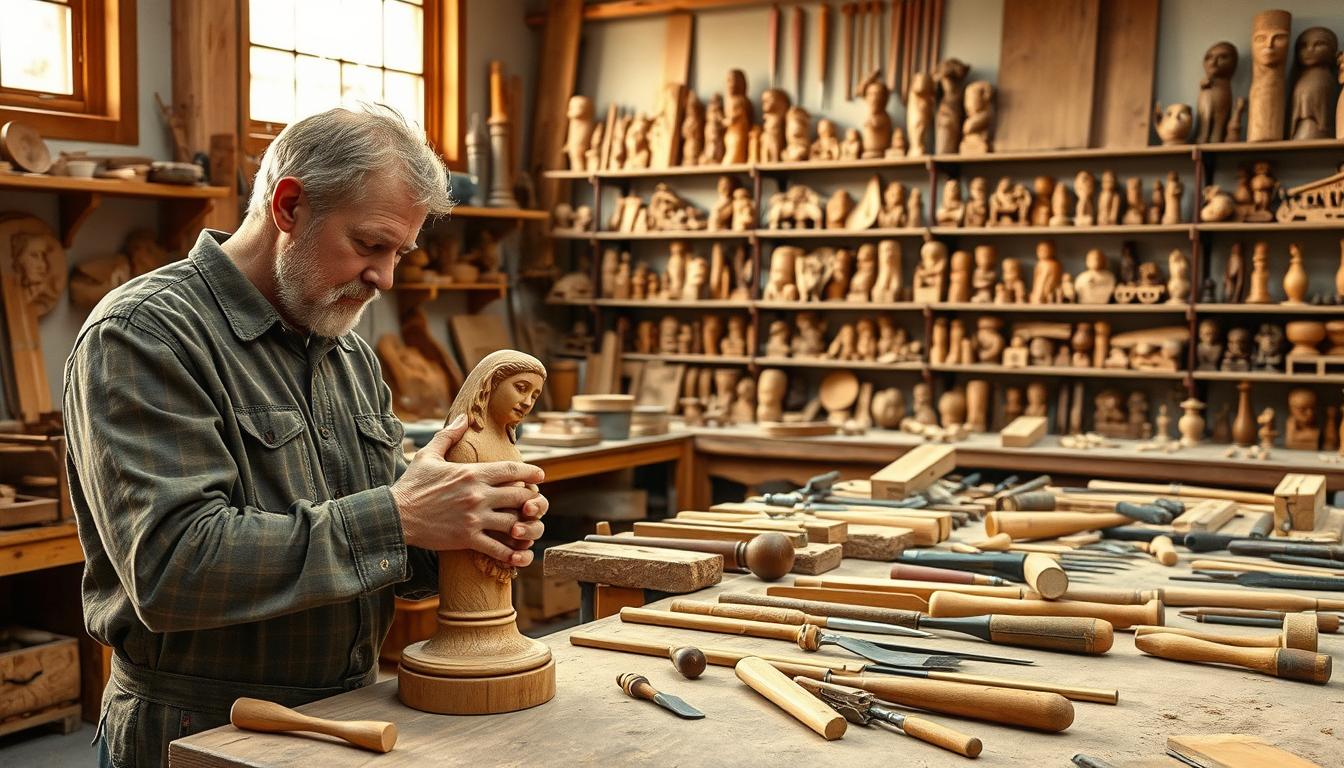
When looking for the best wood carving training programs, there are key factors to consider. First, check the instructors’ credentials and teaching history. Stay away from programs that push tool sales over learning. Instead, choose those that focus on teaching principles.
Look for instructors with real-world experience and success stories. For example, programs with a 90% instructor recommendation rate are a good sign8.
Instructor Credentials and Experience
- Verify credentials: Check if instructors have certifications or industry recognition.
- Watch for bias: 70% of beginners prefer programs where instructors prioritize skill over equipment sales9.
- Ask about teaching philosophy: Ideal mentors balance theory and hands-on practice.
Curriculum Comprehensiveness
Top wood carving classes should cover the basics well. For example, 80% of graduates master the four core cuts—paring, push, stop, and V cuts8. Look for programs that mix traditional and modern techniques. A good program also teaches tool sharpening, project-based learning, and safety.
Student-to Teacher Ratio
Small classes mean more personal attention. Programs with just a few students per year, like the 9-month intensive course, offer better guidance10. This helps in mastering precision techniques.
Workshop Facilities and Tool Availability
Make sure the facilities have quality equipment. 100% of courses provide essential tools like chisels and gouges8. Look for workshops with good lighting and safe spaces. Ask:
- Do they have ergonomic setups?
- Is maintenance training included?
Also, ask about tool accessibility and workspace safety. Programs like Keith Randich’s focus on sharpening techniques rather than gadgets9.
Top Online Wood Carving Classes for Remote Learning

Online wood carving classes open doors to learning from home. You can find classes with videos, live sessions, and subscription services. These classes offer 24/7 access and flexible schedules11. You can pick from monthly subscriptions or annual memberships, depending on your learning pace.
Checkout some of the great videos, you can try a monthly subscription or for best value, an annual subscription for you or as a gift to the woodcarver in your life.
Self-Paced Video Courses
Udemy and Skillshare have lessons for all skill levels11. These courses let you learn at your own speed. They include guides and project checklists. They’re perfect for those who learn best by watching.
Live Virtual Workshops
Live sessions combine online and in-person learning. A Workshop of Our Own offers real-time classes with instructors12. They use multiple cameras to show chisel work and allow for instant questions. These workshops are great for those who want direct feedback.

Subscription-Based Learning Platforms
Woodcarving Academy gives you unlimited access to over 3,000 videos11. Annual plans are under $23.99/month11. The Chairmaker’s Toolbox even offers scholarships for underrepresented groups12.
| Type | Examples | Cost | Features |
|---|---|---|---|
| Self-Paced | Udemy, Skillshare | $23.99+/month11 | On-demand lessons, beginner-friendly |
| Live Workshops | A Workshop of Our Own | Varies by session | Real-time feedback, interactive |
| Subscription | Woodcarving Academy | $23.99/month11 | 24/7 access, multi-instructor content |
Subscription platforms have forums and challenges to keep you sharp. They also offer certification tracks to track your progress. Look into these options to find what works best for you.
Prestigious In-Person Skilled Wood Carving Workshops
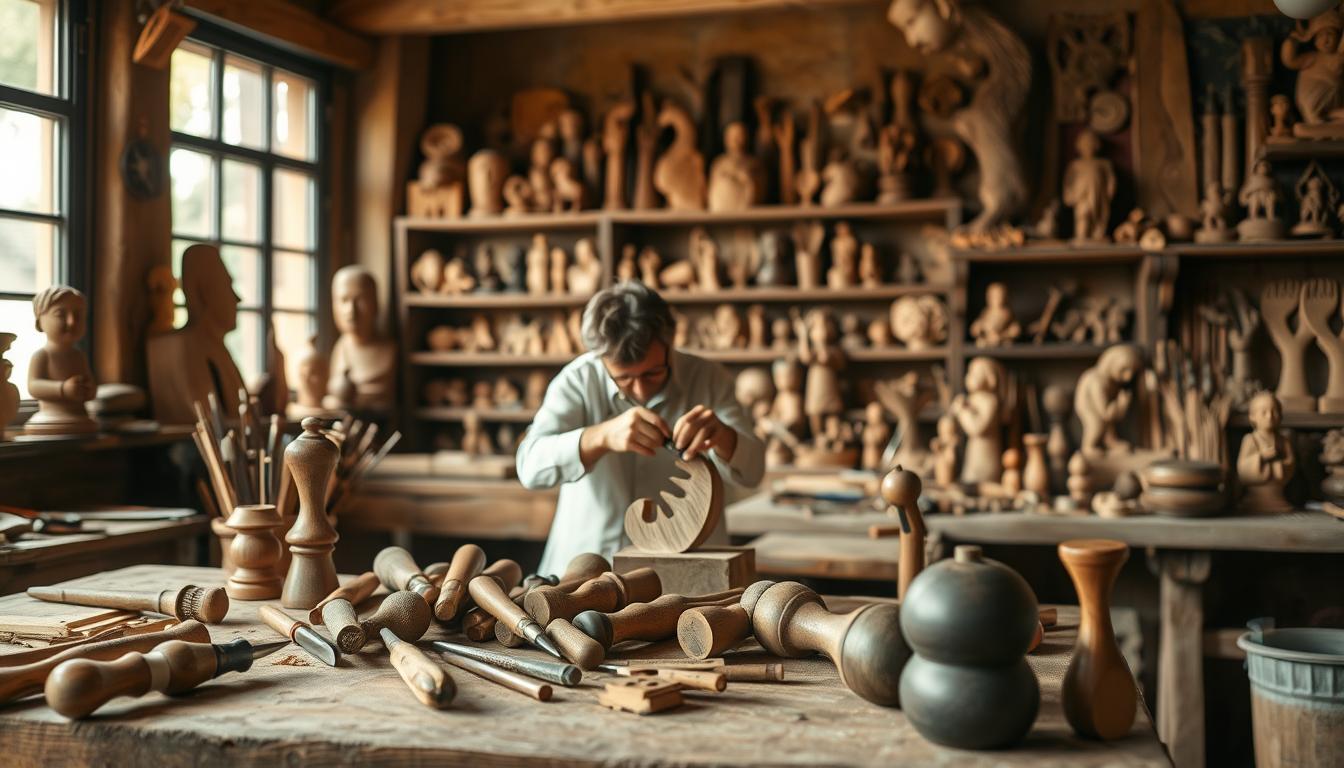
Wood carving workshops offer hands-on learning you can’t find online. At North House Folk School in Minnesota and Tennessee’s John C. Campbell Folk School, you learn from master carvers. These professional wood carving courses
- Arrowmont School of Arts and Crafts in Tennessee teaches Scandinavian flat-plane carving, a style popular in Midwest workshops.
- Coastal programs like those in Maine focus on nautical motifs, combining history with practical skill-building.
- Five-day sessions start at $900, with tools and travel adding $3,000 total costs13.
These workshops give you direct feedback on how to handle tools and stand. Many schools offer lodging, making them perfect for deep learning. To join, sign up for notifications via platforms like TXRX to get updates on class schedules13. Weekend workshops let beginners carve their first project in 2 days, while advanced sessions tackle complex designs over weeks.
“Sharpening is the gateway skill to carving mastery,” emphasize instructors, a focus in all introductory sessions14.
Whether you want to improve traditional skills or start a new project, these programs connect you with carvers. Check class pages to reserve spots early, as popular sessions fill quickly. Your investment in these workshops builds both skills and lasting craft relationships.
Leading Wood Carving Tutorials for Beginners
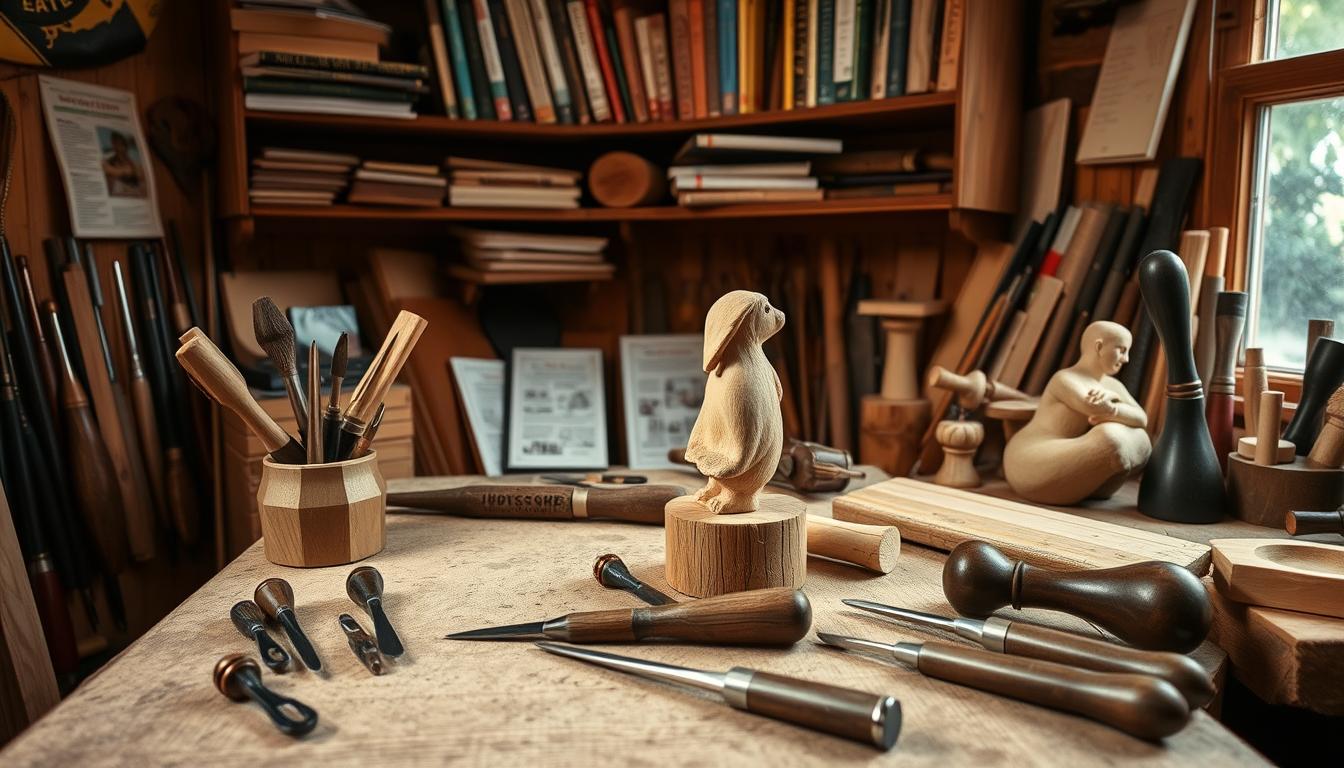
Start your wood carving journey with leading wood carving tutorials made for beginners. These tutorials focus on safety, proper form, and skill growth. You’ll learn wood carving techniques through fun projects like spoons or geometric patterns. These projects help improve your dexterity without feeling overwhelmed15.
“Sharpening is the gateway skill to learning handwork, carving, turning and many other corners of the craft. And, with a good teacher, it isn’t hard to learn.”15
Foundation Courses That Build Proper Technique
Top courses teach you the basics, like how to hold tools and read wood grain. Many programs include:
- Introductory sessions on basic cuts and body positioning
- Hands-on practice with safe tool handling
- Guidance on selecting beginner-friendly woods like basswood or butternut15
Over 43.75% of courses focus on spoon carving and traditional methods. Most courses last 3 days, mixing theory and practice16.
Tool Selection and Maintenance Programs
Choosing the right tools can be tough for beginners. Reputable tutorials teach you about whittling knives, gouges, and sharpening stones15. In 75% of introductory programs, you’ll learn how to clean and oil your tools16. It’s important to sharpen tools properly to avoid frustration and injuries15.
Project-Based Learning for Newcomers
Structured projects like carving spoons or simple animals help you apply what you’ve learned. Many programs offer 12 different projects16. Even short 3-day courses include 2-3 projects to track your progress16.
Advanced Wood Carving Instruction for Experienced Craftspeople

Professional wood carving courses are for those who already know a lot. Advanced wood carving instruction helps carvers improve their skills. They learn from master artists and get better at winning competitions.
These courses offer feedback from peers and access to new tools like CAD software. This makes designs more precise17.
Specialized Style Development
There are many styles to explore, from traditional to modern. Dwayne Gosnell teaches about facial anatomy, like in his All About the Eyes series18. He shows how to create realistic expressions.
Students also learn historical styles, like 18th-century Windsor chairmaking. Luke Barnett, a three-time Top American Craftsman award winner, teaches this19.
Master Classes with Renowned Carvers
Learn from the best, like Alexander Grabovetskiy, the 2012 International Wood Carver of the Year19. Master classes offer live demos and personal coaching. Steve McCarroll, a 2023 graduate, credits his mentors for his success18.
These sessions focus on mastering tools, like high-relief gouges for detailed textures.
Competitive Technique Refinement
For those aiming to compete, detail is key. Dylan Goddson teaches about nose-and-mouth adjustments that judges look for18. Training includes mock-judgings to learn what judges value.
Some courses use CNC machines for precise patterns. Graduates like Katrina Tompkins create stunning pieces for galleries18.
Accredited Wood Carving Sessions and Certification Options

Choosing accredited wood carving sessions means understanding the certification options. Many wood carving training programs give out credentials. For instance, a 40-week program starting August 25, 2025, costs $15,110 in tuition plus $3,694 for tools20. After graduating, you get a certificate that employers in architectural restoration and commercial carving value20.
- Certificates of completion: Given when you finish the program20.
- Industry certifications: Guilds like the American Woodcarvers Association offer them, after skill tests.
- College credits: Some programs let you transfer coursework to associate degrees20.
| Credential Type | Cost | Timeframe |
|---|---|---|
| Basic Certificate | $15,110 tuition20 | 40 weeks20 |
| Advanced Certification | $7,555 deposit + final payment20 | Includes 24 weekly hours of lab and classroom time20 |
Curricula like the 2025-2026 one include 10 furniture projects1. These align with 4.7% of 85 projects that focus on detailed designs1. Make sure the program is legit by checking with bodies like NASAD or guilds. A certificate can increase your salary—grads make $51,822 to $54,206 a year20.
Before signing up, check if employers in your area value formal credentials more than portfolios. Many woodworkers combine certifications with hands-on experience. This helps them master styles like Gothic or Acanthus Leaf1.
Cost Analysis: Investment vs. Value in Wood Carving Education
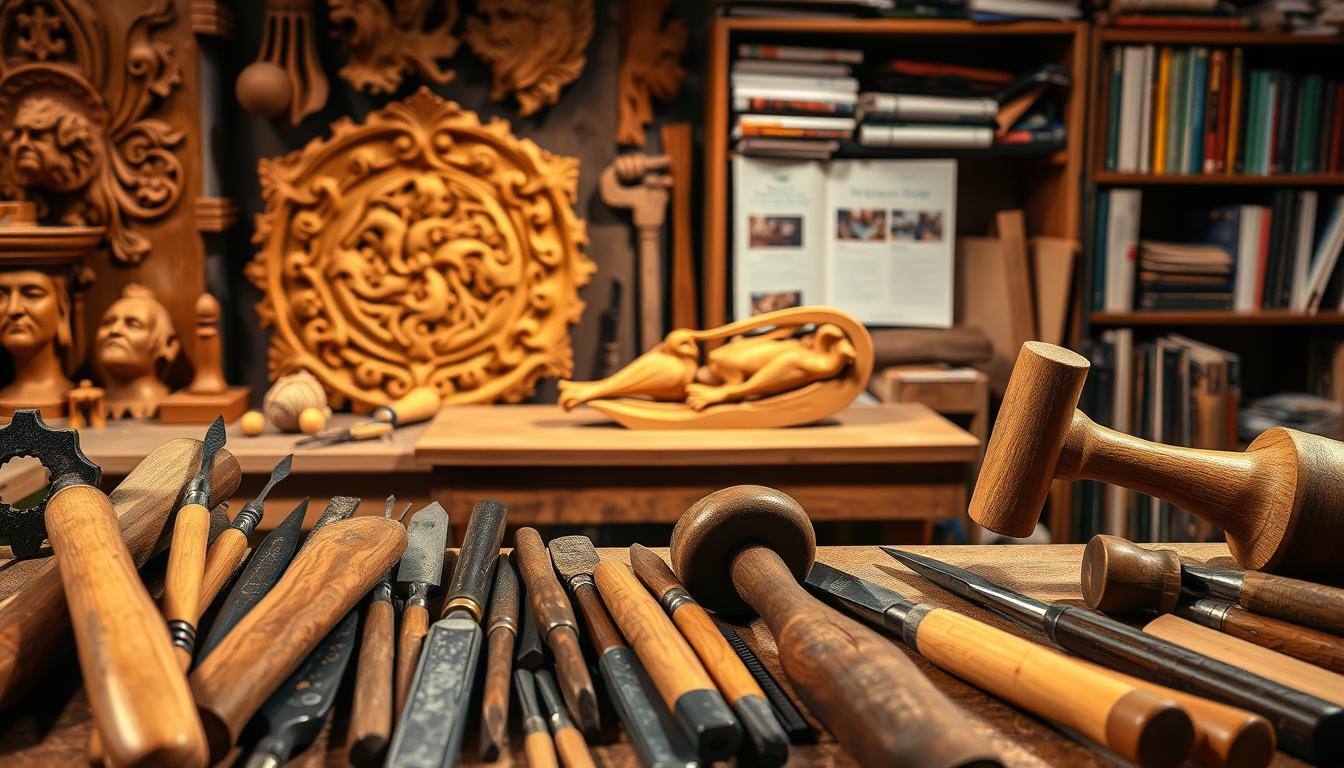
Choosing the right best wood carving training programs means looking at costs and benefits. Many carvers struggle with the costs of top wood carving classes.
“Even seasoned carvers face high costs that limit access to top wood carving classes.”
Budget-Friendly Starting Points
- Community center workshops ($50–$150 per course) often include tool rentals
- Free online tutorials supplement hands-on practice but lack instructor feedback
- Carving club memberships ($20/month) offer material discounts and shared tool access
Hidden costs like safety gear and materials can take up 42% of your budget21. Look for scholarships or early-bird discounts to help.
Mid-Range Comprehensive Programs
Mid-tier programs like regional craft schools ($500–$1,200) offer structured curricula. They teach tool maintenance. Subscription platforms like CraftMaster (starting at $39/month) provide project-based learning. This aligns with the industry’s 4% annual growth22.
These options balance affordability with skill development. They help you reach median carpentry wages of $51,39022.
Premium Boutique Learning Experiences
- Master carver intensives ($2,000–$5,000) include one-on one critiques
- Certification programs may boost earning potential via specialized techniques
Social capital networks formed here reduce long-term business transaction costs21. Ideal for carvers aiming to enter luxury markets.
Ask: Does this program’s cost align with your career goals? Compare tool requirements, travel expenses, and certification outcomes before committing. Hidden costs like dust collection systems (required by OSHA standards) add to expenses22.
How to Choose the Right Program for Your Specific Goals
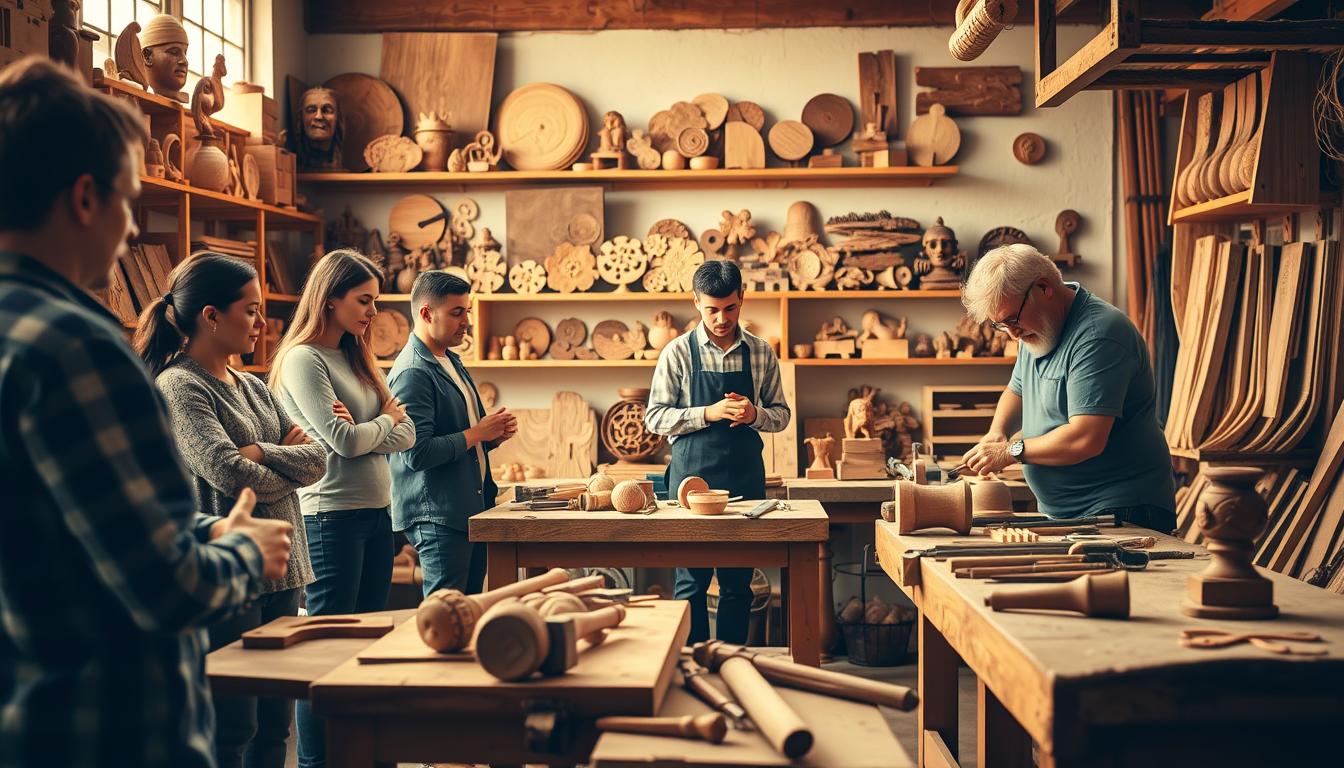
Choosing the right wood carving training programs begins with knowing your goals. Ask yourself: Do you want to make decorative items, sell crafts, or learn advanced techniques? Your goals will guide your search. If you prefer hands-on learning, skilled wood carving workshops offer direct mentorship. Online options provide flexibility, allowing you to learn from home.
“If I could take only two woodworking classes, what would they be?” Focus on core skills like sharpening or joinery first. Start with the basics before moving to specialized topics23.
Here’s a checklist to help you:
- Assess your skill level: Are you a beginner or aiming for advanced projects?
- Check program content: Does it match your goals? For example, “Fundamentals of Cabinet Making” teaches essential joinery23.
- Verify instructor expertise and student reviews. Over 6,000 students rated the Vectric Master Training Course at 99% satisfaction24.
Consider time and budget. Some online courses are under $100, while premium programs like the Vectric course offer $1,700 worth of content24. Try free trials or classes. Also, ask alumni about their experiences.
Blend different learning methods. Start with a $100 beginner course23, then move to advanced wood carving training programs. Focus on safety, like learning about table saw blades in “Table Saw Essentials”23. Don’t overcommit: Even the 8-level Vectric course lets you learn at your own pace in 1 week or a month24.
Remember, learning takes time. Mix online and in-person learning to build a well-rounded skillset. Your journey depends on your goals and how you learn best.
🔥 Turn Your Woodworking Dreams Into Reality! 🔥

Looking to master wood carving or build stunning woodworking projects with ease? Ted’s Woodworking is your ultimate resource!
✅ 16,000+ Ready-to-Build Plans – No guesswork, just follow the step-by-step instructions.
✅ Perfect for Beginners & Pros – Simple to advanced projects for all skill levels.
✅ Detailed Schematics & Cutting Lists – Save time, money, and effort.
✅ Lifetime Access & Monthly Free Plans – Never run out of ideas!
✅ Bonus: 150+ Video Tutorials & Business Guide – Turn your hobby into a profitable venture.
🚀 Don’t Miss Out! Get Instant Access Now for Just $67! 🚀
👉 Click Here to Grab Your Plans Today!
Conclusion: Taking the Next Step in Your Wood Carving Journey
Learning wood carving is key. Over 70% of woodworkers go to workshops or online tutorials to get better. Accredited wood carving sessions teach you the right way to improve, helping you avoid mistakes. With 20 million Americans doing woodcraft every year, it’s a great time to learn more25.
Start with learn wood carving techniques using basswood. It’s easy for beginners. Try making spoons or rosettes first26. Learning about tool care and grain direction is crucial for 65% of carvers25. As you get better, take more advanced courses. For the experts, teaching others is a great way to share your skills26.
Good resources are essential for growth. The School of Wood Carving has over 3,000 tutorials for all levels26. Experts say keeping up with trends and techniques is key, as the market is growing fast25. Even 60% of experienced carvers use French polishing for a smooth finish25.
Wood carving is all about community and practice. Join online forums or local clubs to meet others. This can make you 30% more creative25. Start with basic tools, take care of them, and keep practicing. The craft combines tradition and new ideas, offering endless possibilities. Whether you’re new or experienced, there are programs and resources to help you grow. Start today—your next project is waiting.
FAQ
What are the benefits of enrolling in a professional wood carving course?
Enrolling in a professional wood carving course offers many benefits. You get structured lessons and immediate feedback on your work. This helps you avoid mistakes and learn faster.
How do online wood carving classes compare to traditional in-person workshops?
Online wood carving classes are flexible and let you learn at your own pace. But, they lack the hands-on help and feedback of in-person workshops. Workshops offer a community feel and direct instructor guidance, which is great for improving your skills.
What types of wood carving techniques can I learn in a formal program?
Formal programs teach a variety of techniques. You’ll learn relief carving, chip carving, and more. They start with basics and move to advanced skills, helping you become well-rounded.
How should I evaluate instructors when choosing a wood carving program?
When choosing a program, look for experienced instructors with a strong artistic background. Check their teaching history and artistic achievements. Choose instructors who focus on teaching, not just selling tools.
What are some recommended programs for beginners in wood carving?
Beginners should look for programs that focus on basics and safety. Choose courses with project-based learning and tool selection. This helps new carvers build skills and understand tool care.
Are there any certification options available in wood carving education?
Yes, many programs offer recognized certifications. These can boost your career, whether in architectural woodcarving or restoration. Look for programs from accredited schools or guilds.
How can I balance costs when investing in wood carving education?
Begin with affordable options like community classes or online tutorials. These provide essential skills. As you grow, consider mid-range programs. For advanced skills, invest in high-end programs to improve your career and art.
What factors should I consider when choosing the right wood carving program?
First, think about your goals in wood carving. Do you want to enjoy it as a hobby or make a career? Consider your learning style, budget, and whether you prefer hands-on or online learning. Look at the program’s curriculum, teacher-to-student ratio, and instructor qualifications.
Source Links
- Mary May’s School of Traditional Woodcarving – https://marymaycarving.com/
- Woodcarving | WoodenBoat School – https://www.thewoodenboatschool.com/courses/woodcarving/
- 4 Best Wood Carving Courses and Classes For Beginners [JAN 2025] – https://coursesity.com/blog/best-wood-carving-courses/
- Are Woodworking Classes Worth Your Time And Money | Wood Art Studio – https://woodart.studio/2021/08/18/are-woodworking-classes-worth-your-time-and-money/
- What is the Potential to Make Money from Carving Wood: Tips for a – https://schoolofwoodcarving.com/how-much-money-can-i-make-from-wood-carving/
- Wood Carving. How Long Does It Take to Learn How to Carve Wood? – https://schoolofwoodcarving.com/wood-carving-how-long-does-it-take-to-learn-how-to-carve-wood/
- Wood Carving Techniques for Beginners – https://beavercrafttools.com/blogs/how-to-carve/wood-carving-techniques-for-beginners?srsltid=AfmBOoq8hcq3oKCLWhyWLcmMfzyckQMh9O2skQZtqcf66bAOv9eFZrf-
- Guide to… wood carving – https://www.craftcourses.com/guide-to-wood-carving
- Improving your carving skills – https://www.woodmagazine.com/woodworking-how-to/woodworking-scrolling-carving/improving-your-carving-skills
- 9 month Fine Woodworking | Two Rock School – https://www.tworockschoolofwoodworking.com/9-month-fine-woodworking
- online | Grabovetskiy School of Wood Carving – https://schoolofwoodcarving.com/wood-carving-classes-new-jersey-2/wood-carving-courses-in-union-nj/
- Great places to learn – FineWoodworking – https://www.finewoodworking.com/2024/05/07/great-places-to-learn?srsltid=AfmBOooGnSA8vRgjsXuErgTJ6fDqka2VrwkR_svcgHleQ7IQGV_uifFS
- Learn Woodcarving: Wood Carving Classes for Beginners – https://schoolofwoodcarving.com/wood-carving-classes-for-beginners/
- Woodcarving classes near me | wood carving classes online | – https://schoolofwoodcarving.com/woodcarving-classes-near-me-wood-carving-classes-online-school-of-wood-carving/
- Wood Carving Techniques for Beginners – https://beavercrafttools.com/blogs/how-to-carve/wood-carving-techniques-for-beginners?srsltid=AfmBOorB6KdZb6gmD4UHKGgCt2vwTEQYkE5QGQmj2R-vY0cGhK-HE9qk
- North House Folk School – https://northhouse.org/courses/category/woodcarving
- Beyond the basics: advanced wood carving tools and techniques – https://stryicarvingtools.com/blogs/news/beyond-the-basics-advanced-wood-carving-tools-and-techniques?srsltid=AfmBOooNrn0t_LPUX2YlD-mRJJXqYjg3QPvd47118sDWZEyWO7gDyN1L
- Classes – Phoenix Forge – https://phxforge.com/classes/
- Intensive Continuing Education Courses — Sam Beauford Woodworking Institute – https://www.sambeaufordwoodshop.com/intensive-woodworking-courses
- Woodworking School — Sam Beauford Woodworking Institute – https://www.sambeaufordwoodshop.com/woodworking-school
- Empowering small industry of wood carving handicraft in Bangli district – https://www.emerald.com/insight/content/doi/10.1108/apjie-07-2018-0045/full/html
- Launch Your Woodworking Business: A 2024 Success Guide – https://globemonitor.co/woodworking-business/
- 18 Best Online Woodworking Classes – https://www.manmadediy.com/online-woodworking-classes/
- Master Vectric Software – Learn CNC Like a Pro with Expert Training – https://academy.learnyourcnc.com/lp/vectric-master-training-course
- Wood Carving: Pro Tips for Advanced Woodworkers – https://www.popularwoodworking.com/review/wood-carving/
- How do I Learn to Carve Wood? | Woodcarving Course | School of – https://schoolofwoodcarving.com/how-do-i-learn-to-carve-wood/

